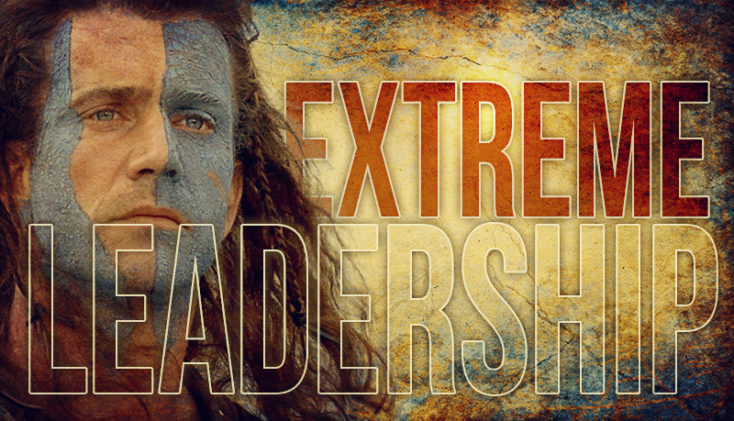William Wallace (as depicted in the movie Braveheart) was an extreme leader. I don’t think anyone would dispute that. But what might surprise you is why I call him an extreme leader. Hint: it has nothing to do with face paint, kilts or screaming. It has everything to do with selflessness, courage and influence. Ok, but what does that have to do with us?
The construction industry has a leadership crisis. Getting and keeping the right people to take a company to new heights is harder than ever, and those who differentiate themselves enough to attract and keep top talent inevitably do so through superior leadership–Extreme Leadership.
When I started my paving company at nineteen years old, I was contributing to the crisis. You see I was an extreme leader–an extremely bad one! Don’t get me wrong. From the outside looking in, I was successful. I had been successful in my own mind. I was successful to many people looking in. But I was not successful according to those who worked with and for me. I was not a beloved leader. I was achieving a selfish success. I was all about what my people could do for me to help me reach my goals. It was even gratifying for a short period of time for me. But eventually I realized my leadership style was not scalable or even deeply satisfying.
In order to grow I had to make the transition as a leader to focusing on my people. My mentor John C. Maxwell told me “If you want to know how you’re doing as a leader, just ask the followers.” A few years later my company was named Equipment World magazine’s national Contractor of the Year, an achievement that would have been impossible without the decision to embark on the journey to becoming an extreme leader.
So what is extreme leadership and how to we develop it?
The word extreme can sometimes have the negative connotation of meaning: “excessive”. But in this case, the word extreme simply indicates the degree to which it differs from normal or average leadership. What is different is often thought of as extreme. It is extreme leadership precisely because it isn’t average or normal.
Extreme Leadership is: Selfless, courageous influence that inspires lasting greatness in others.
Selfless…. Courageous…. Influence … that Inspires lasting Change in others.
That definition probably sounds like quite a lofty goal to aspire to, and it is! Average? No! Normal? Hardly. But this is exactly the sort of leadership that will set you and your company apart and create a culture that attracts and retains top talent.
Extreme Leadership is: Selfless, courageous influence that inspires lasting greatness in others. Click To TweetThough there are many elements of extreme leadership that can be closer examined, I’ve identified three primary areas of focus if one is to become an extreme leader.
1. Self-Leadership
It seems preposterous that anyone would be in a position of leading others without first learning to lead themselves well, but this vital step is overlooked far too often. Self-leadership and self-discipline are inseparable. Whether making a decision that will benefit others rather than yourself or establishing healthy relationship habits, self-leadership models a high level of integrity that inspires confidence in those who follow.
2. Influence
My mentor John Maxwell said:
“True leadership cannot be awarded, appointed, or assigned. It comes only from influence, and that cannot be mandated. It must be earned.”
In the aforementioned movie Braveheart, the nobles had the land and the power, but held little influence with those they lorded over. Wallace started with none of the traditional measures of power. However, he earned enormous influence. The same is true in many organizations. Influence dictates the effectiveness of leadership. When individuals are placed in positions of leadership who have little influence with those in their charge, dysfunction is the inevitable result.
3. Equipping
Much like leadership, equipping for a leader starts with self. The leader must first equip himself with the necessary awareness, skills and tools so that he can then equip others to succeed. Leaders who are prepared in this way are effective problem solvers and, more importantly, they create other effective problem solvers.
Take a second and imagine if everyone in a leadership position at your company embodied the above traits. Would it be easier for your company to reach current goals? Would there be more skilled employee retention? Would there be more promotion from within?
It is possible, and it starts with the man in the mirror. I encourage you to re-watch Braveheart with our definition of extreme leadership in mind. I think you’ll be amazed at how thoroughly William Wallace embodied selfless, courageous influence. With some intentionality and resolve, I know you’ll also be amazed at how well you too can embody extreme leadership and effect lasting change in your environment!
